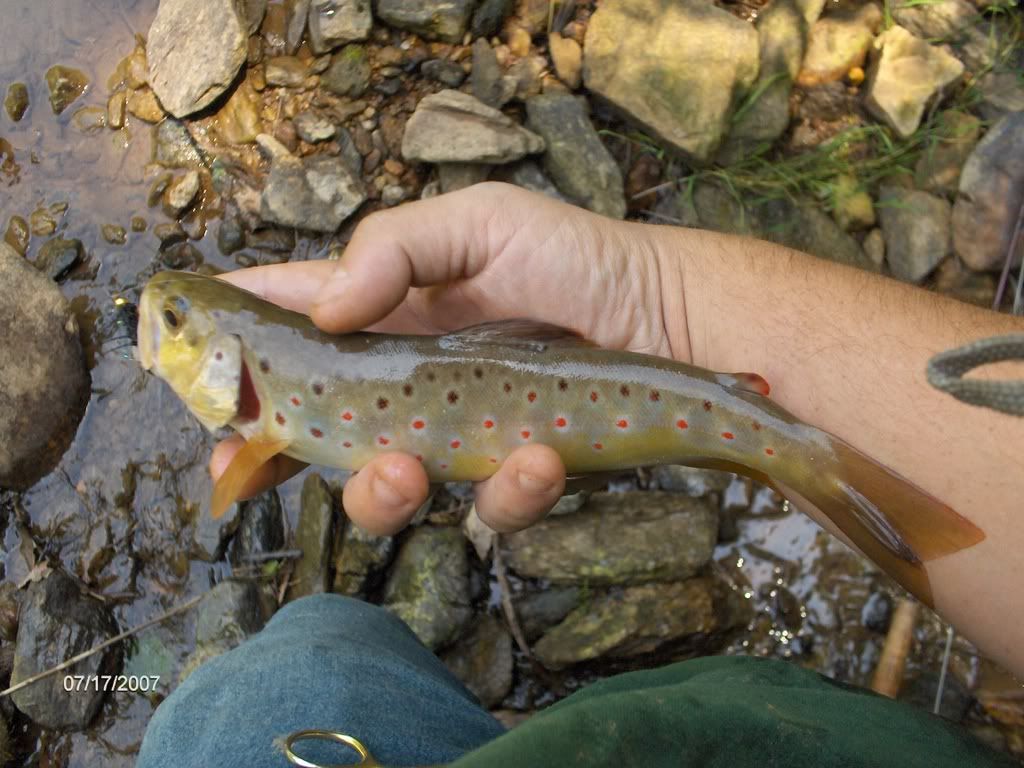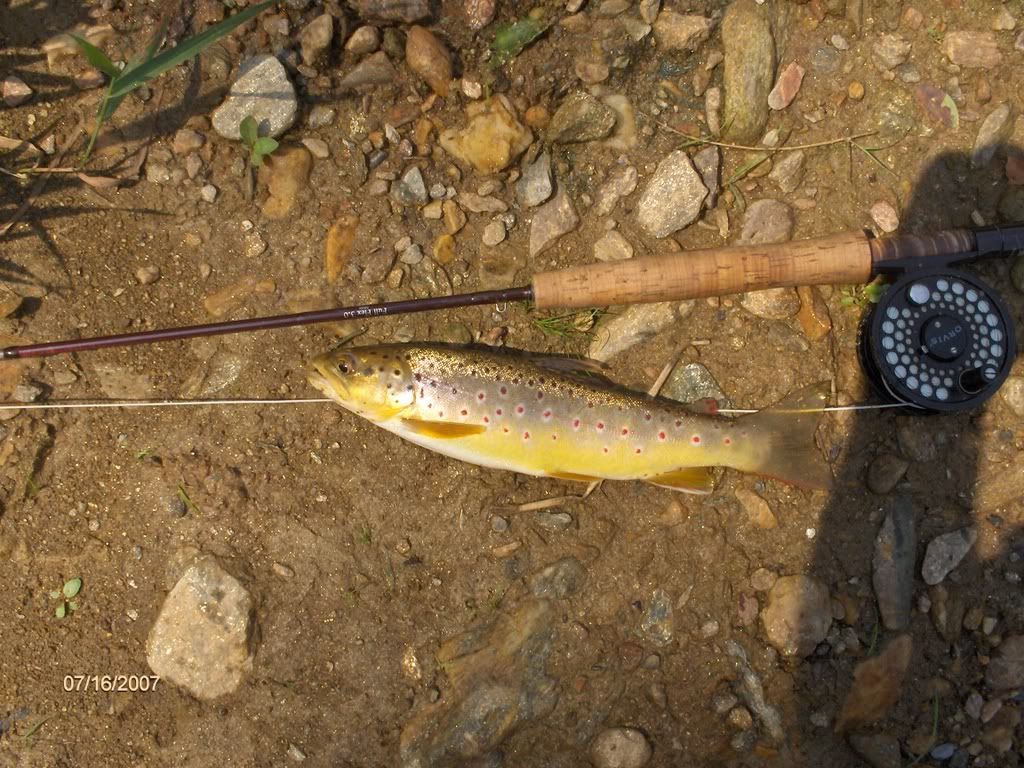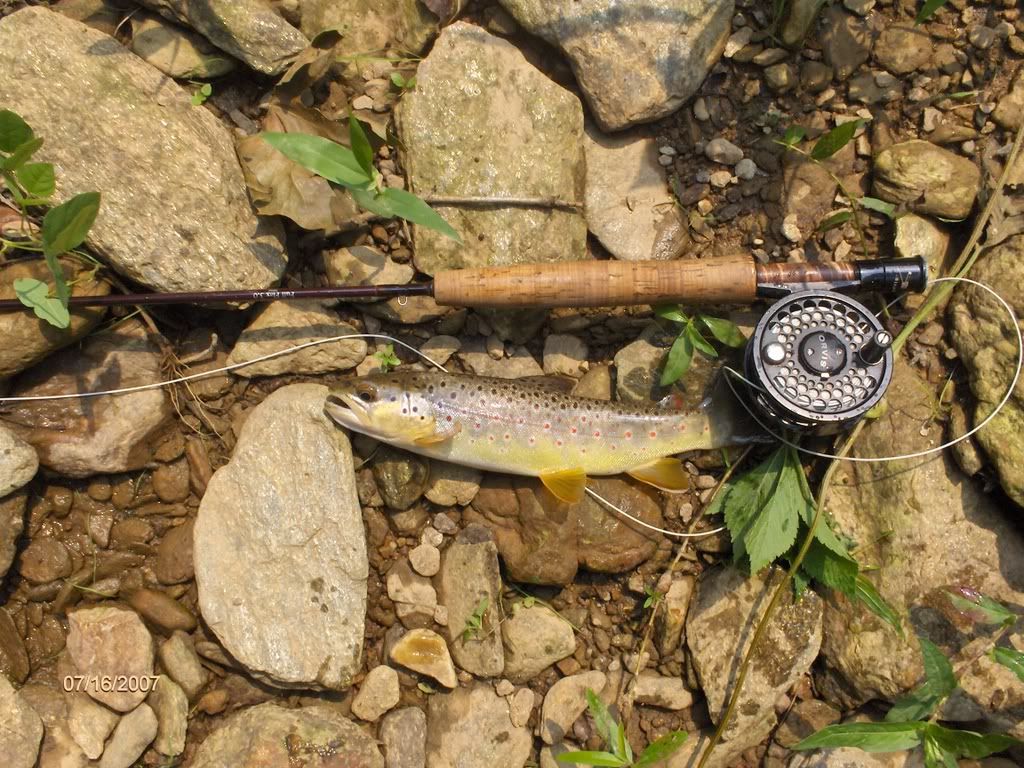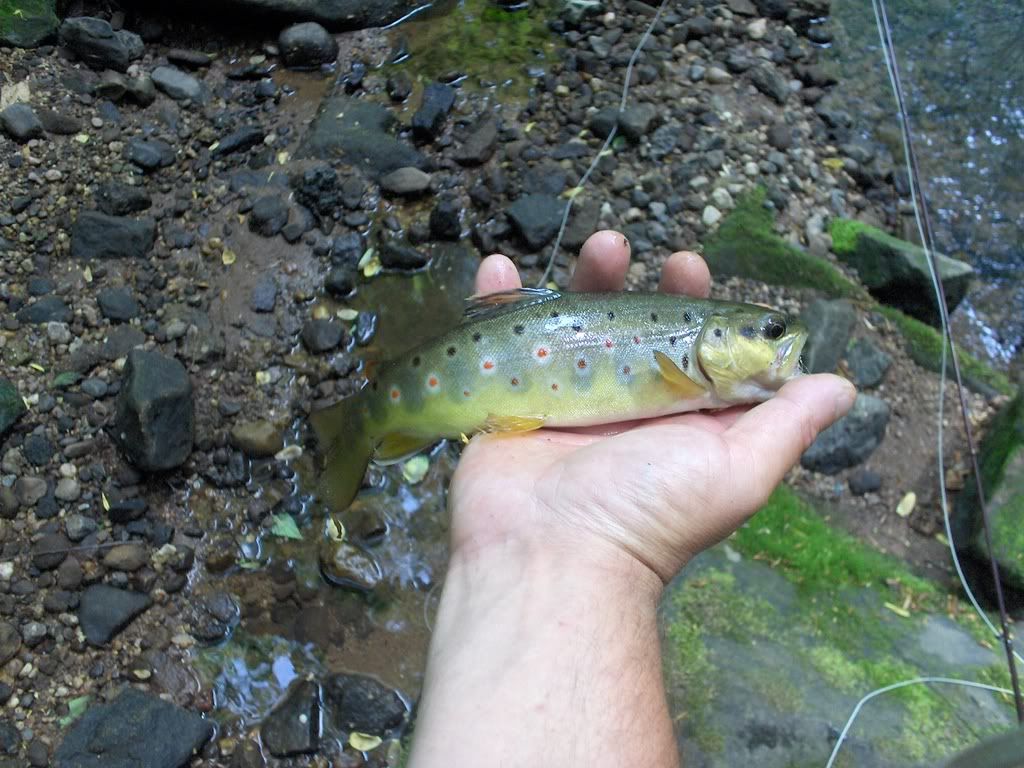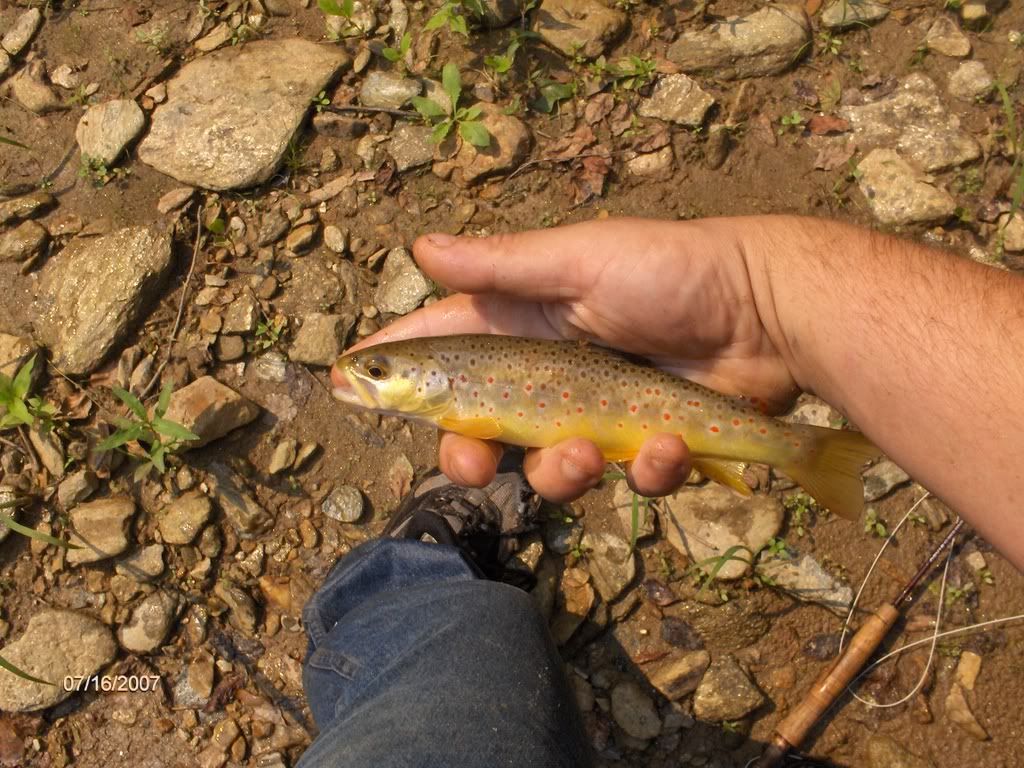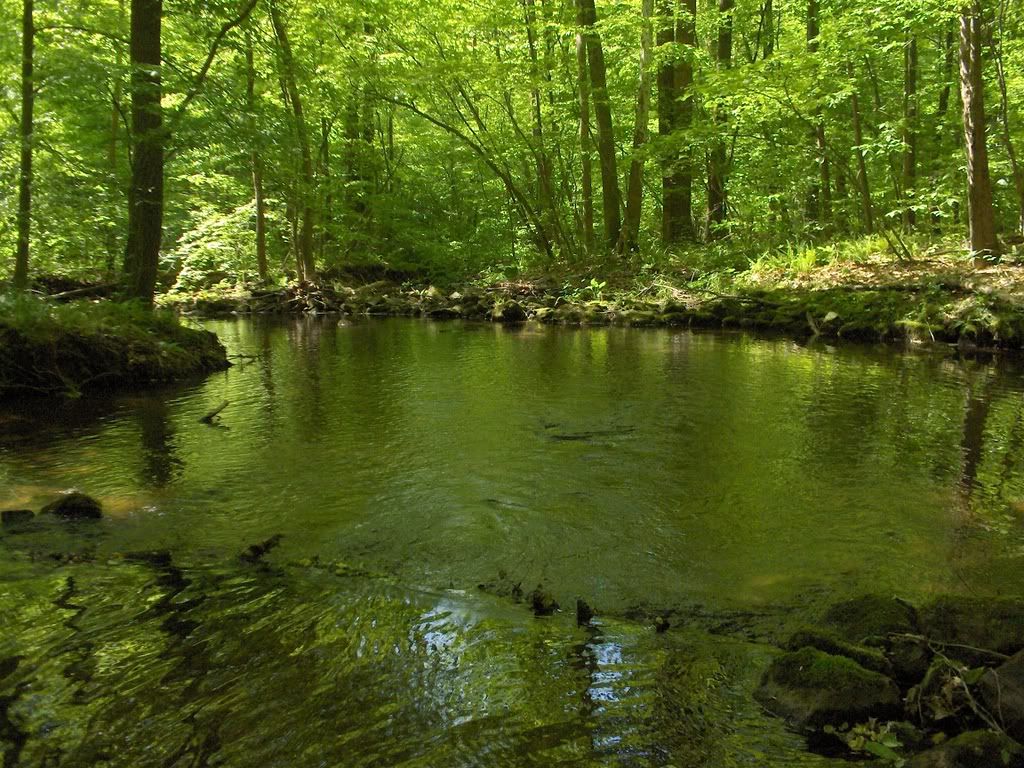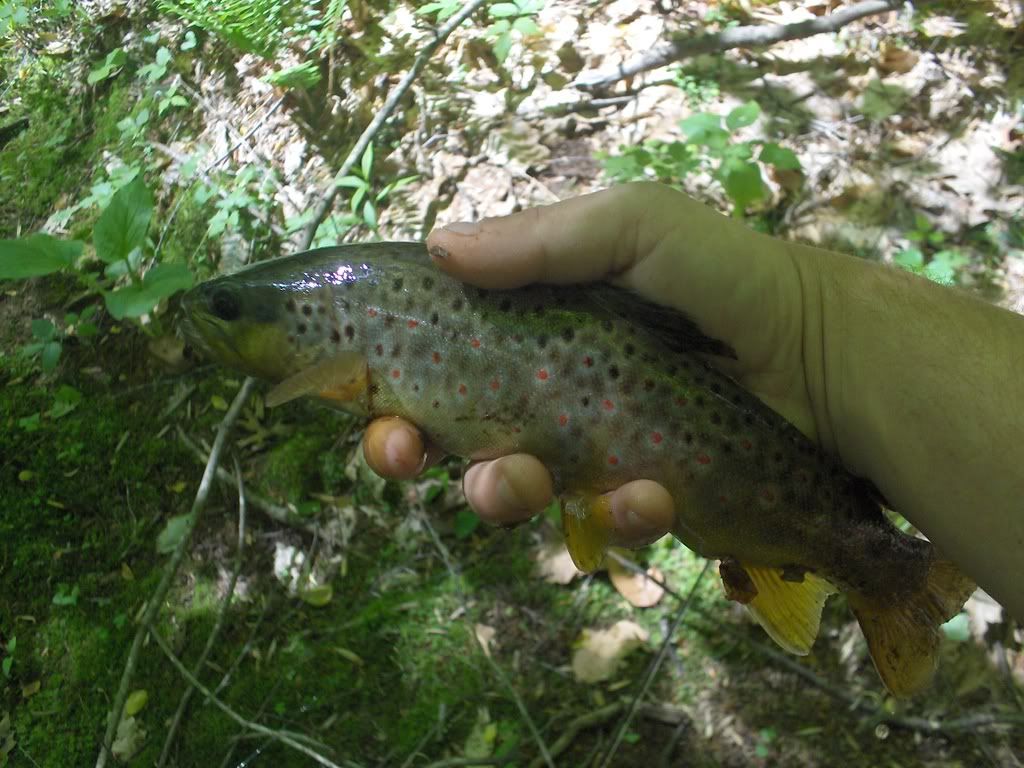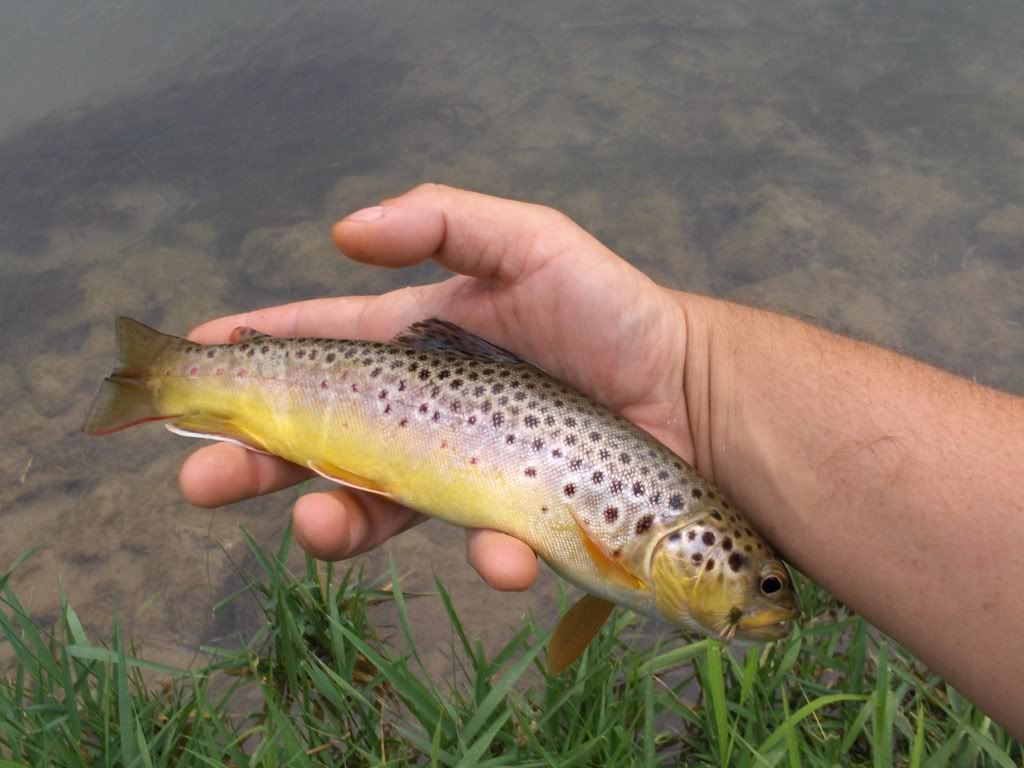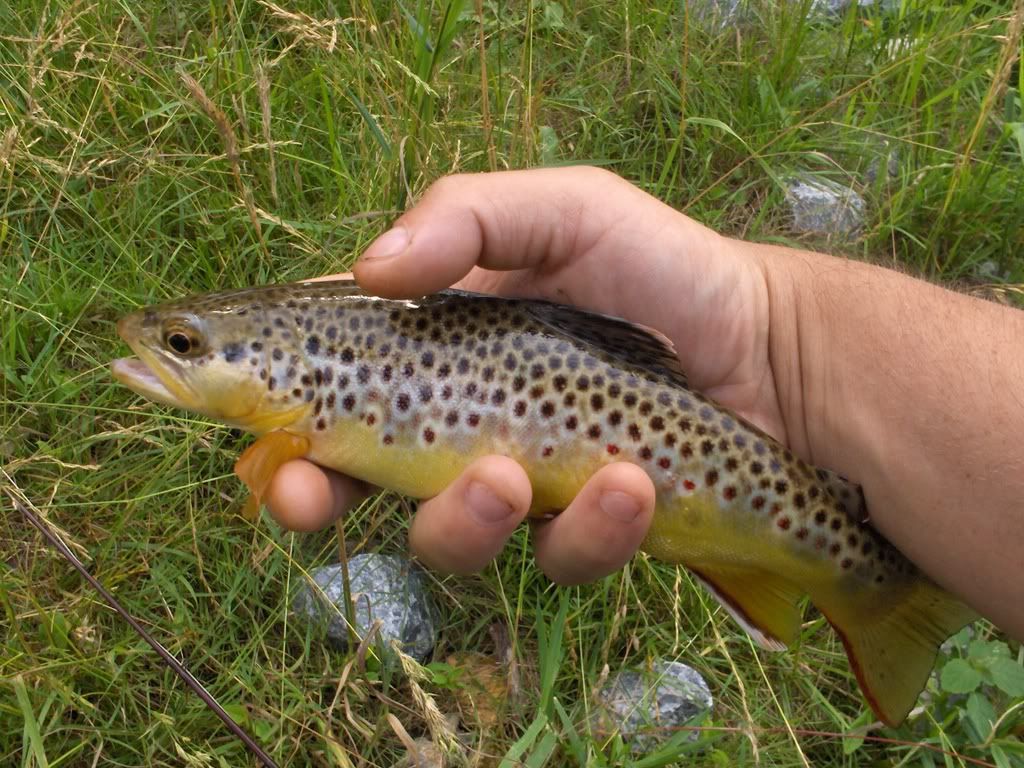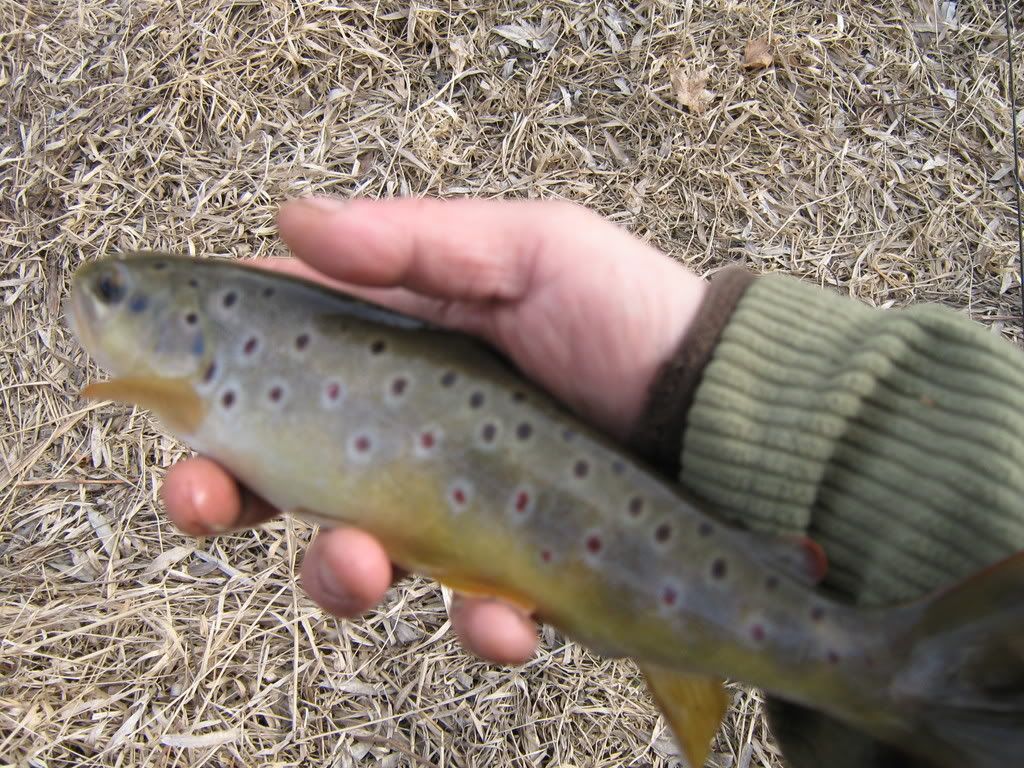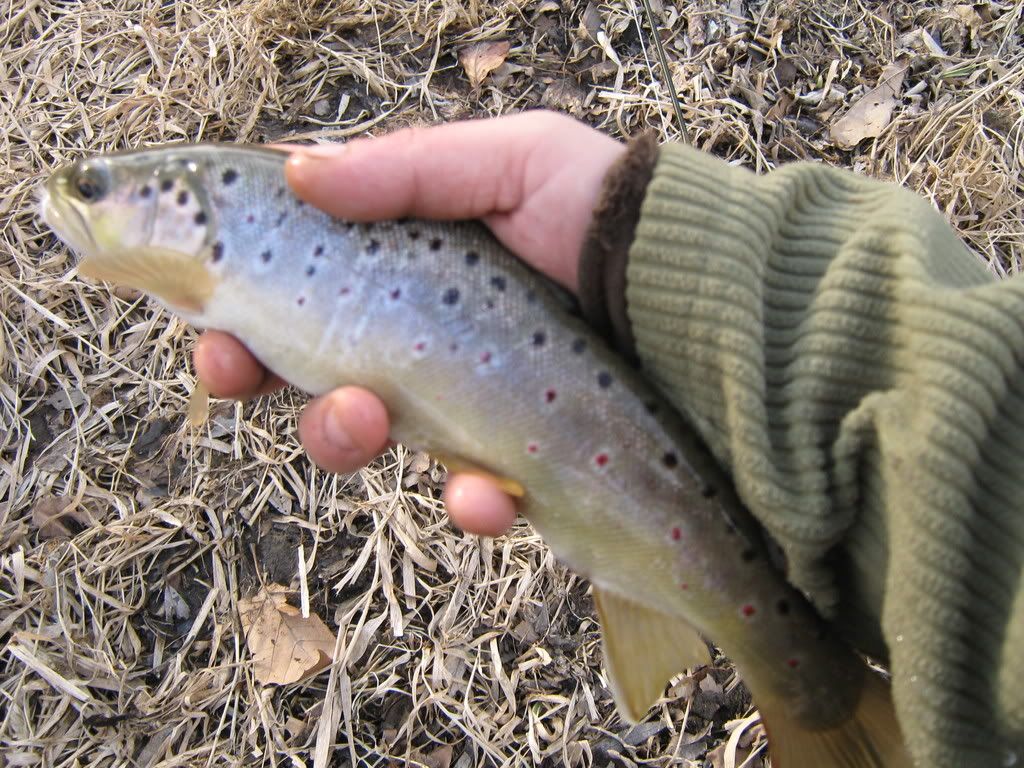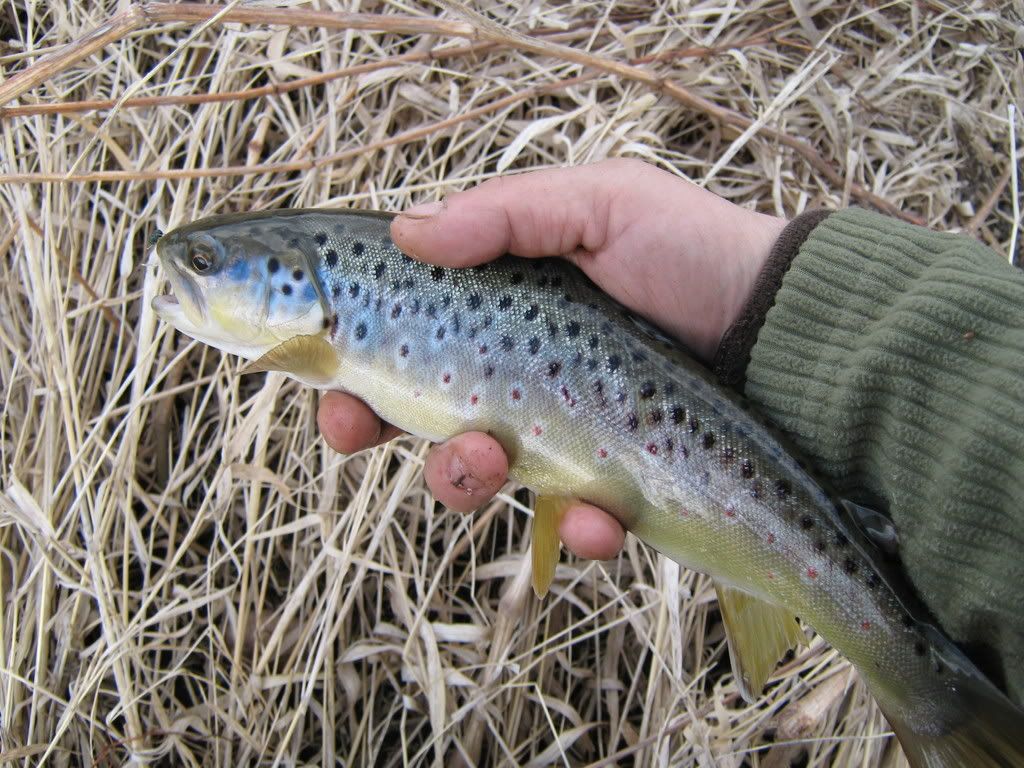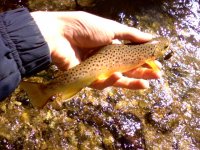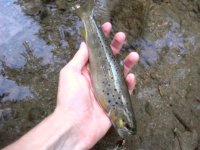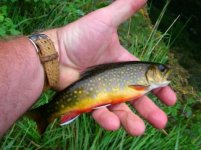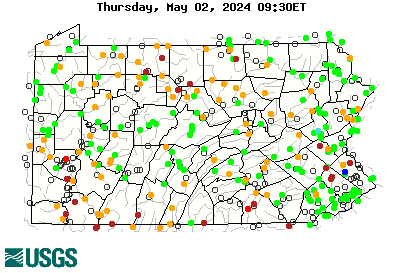salvelinusfontinalis
Active member
- Joined
- Sep 9, 2006
- Messages
- 7,284
Iam by no means an expert, fisheries biologist, scientist or god. So please just know iam very well read, used some personal observations and did some research via the internet for this post. So by all means dispute anything in this post if you feel the need. Offer any information you have to share, this could be a great discussion.
[color=990000]Color:[/color]
I think that first looking @ the obvious is in order. What are some obvious things that can make fish look different from season to season, stream to stream and even fish to fish in one watershed.
Spawning: Spawning Brown and Brook trout will change many physical charateristics including color. A Brown breeding male will develop a long, hooked jaw and brighten in color. Most often becoming much more golden. I, myself, think that the red spots will become brighter also. Brook Trout breeding males colors become more intense and the belly becomes deep-orange. Females will become fat with eggs in both species.
Spawning brookie
While this is obvious sometimes Time of year plays a role in fish coloration. Im sure 1 month after the spawn Browns and Brooks could be brighter than say 6 months after. Also 1 month before i would assume them to be coloring some. I would actually like to know how long Brown and Brook Trout keep there color after the spawn. I couldnt find the answer and i never really thought about it. Anyone?
Habitat: Habitat plays a big role in trout coloration, size and distribution. Yes i said distribution. What could that possibly have to do with trout size? Easy answer.....the better the habitat the more fish likely to be there. The more fish means the more competition for food. A smart trout will find a place with less fish and less competition. Meaning in the end he gets much more food in his belly. This applies to both freestone and limestone streams but it affects freestone trout even more. In Limestone streams there is already so much food that competition doesnt much matter. Try to remember that just because a stream section might have less than favorable habitat, doesnt mean there isnt food in that stretch. Also, very good habitat will allow fish to hide from predators. Living a longer life is one way to get bigger. Limestone Springs are notorious for having good flows, aquatic vegetation and being silty. Silt will not effect fish growth....just spawning. How in the world does habitat effect fish coloration? Well it does in two ways. Here is one example:A rainbow from a deeply shaded mountain stream is often quite dark. Even the belly may be dark gray. I say the same to be true of Brook and Brown trout.
Here is a stream in Central PA:
Stream 1
Take note to the color of the stream bottom. Its a sandy golden color with dark spots. Now look @ the brown that came from the stream:
Brown
Pretty. Hes dark in color but has a very deep golden color. No doubt he has adapted to his habitat and become elusive to the eye. In fact on this fishing trip we had browns right in front of us and didnt notice them until we moved. Even with glasses, if there isnt a sun making a shadow of the fish....they can be hard to see.
What about the brookies in this stream?
Brookie
Hes fairly dark for a brookie also, but i have seen them darker.(ive seen brookies almost black in color) The brookies i have seen that are very dark often come from heavily shaded woods in tannic water. NEPA is good for this. hmmmmmm stained water and dark fish.......seems they have adapted also.
I will say that the smaller fish in this stream are not as dark. Is it possible in their young life, they just havent adapted yet? Possible. Maybe as trout mature they just gain more color. Hard to say for me anyways.
Some of us have even noted that a fish taking a lie in a shaded area will become darker if he has been there a very long time. All the other fish in the more open sections are not as dark. Seems this adaption theory sheds some light on the subject....no pun intended ;-) The second way habitat has an effect on color is habitat for food. Next:
Diet: Diet is one if not the biggest factor associated with color and size. Limestone streams have more food. More food = bigger trout. Color is effected when a trout eats certain foods. I have no idea what properties a brookie must consume to get more orange, but i know from talking with Mike K that it is true. I fished a Lancaster County Stream not on the Natural Reproduction List and caught more than 10 brookies that looked like this:
Brookie
This was not during the spawn but rather in the middle of summer. When i called Mike asking him about the trouts bright color, he said it is possible they eat alot of crustaceans. I dont know what it is about them, but it must color them up well. I would assume the same of browns but i dont know. Thoughts?
Did all the fish look like this?No. Reasons? I dunno, different diets in different stream sections or maybe even 2 different strains of fish. Stains of fish is hard to prove but im sure it happens.
Purple Brookie
The other brookie
Both these fish came from the same stream. Half the fish are purple and the other half are the other color. Could be diet and it could be a different strain. I dunno.
Fish Strength: This is all subjective. One fish can feel like its fighting harder than another, but its more likely they are just playing you better. However there is some truth to this. MKern mention in another post he thiks that Freestone browns swim more for food than they do in Limestone streams. Making a sleeker and stronger fish. That might be true, but i think it has more to do with GRADIENT. Limestone streams are often flat and slow. Little gradient means little current, even with a nice flow. Higher gradient in freestone streams means @ times the fish will have to fight to hold position. Fighting to hold position will burn energy, making the fish thinner but stronger. Its like the comparision of Bruce Willis on a coutch eating potato chips or Bruce Lee chasing down noodles. However........you can have the best of both worlds in PA. Some of my favorite streams are Limestone influenced freestone streams. Fishing Creek comes to mind ;-) Lots of food in a high gradient stream will lead to fatter but stronger fish. With the right foods available.....they will be bright also. Here is a brown that came from a freestone stream in york that is a trib of a Limestoner. Big and bright!
Brown
Limestone influenced streams are my favorite. The trout came from a freestoner but the stream was flooded with small wild browns. I did see 4 that were his size or bigger. I could jump across this stream. They no doubt used the Limestone stream to forage during appropriate times of the year.
Anyways im tired of typing and have contributed a lot to digest. Tell us your thoughts and experiences! Lets make this a good discussion. Time to go hold my baby.
P.S. INTERESTING FACTS ON TROUT COLORATION:
he black spots, the parr marks, and the fine black stippling found on most trout are caused by great numbers of melanophores or black pigment cells filled with microscopic black pigment granules. Similarly, the red and yellow colors are produced by cells filled with red and yellow pigments. Trout and many other kinds of fishes are able to change their colors quite rapidly and they do this by contracting or expanding these pigment cells. When thousands of these tiny cells are expanded the pigment granules are spread out and the fish becomes dark or red or yellow, as the case may be. Then, these cells may be stimulated by nerve impulses and made to contract into pin points of black or of color and immediately the fish becomes much lighter. In addition to this rapid means of modifying color or the intensity of the color, a trout may lose or gain pigment, but this is a relatively slow process. Beneath the skin of a trout is a layer of guanin crystals in cells called guanophores. It is the guanin that gives the trout its silvery appearance. The pigment granules in the chromatophores (black, orange, or yellow) have several different shades of color and different combinations of these shades, together with the guanin, are sufficient to produce all the colors seen in a trout.
[color=990000]Color:[/color]
I think that first looking @ the obvious is in order. What are some obvious things that can make fish look different from season to season, stream to stream and even fish to fish in one watershed.
Spawning: Spawning Brown and Brook trout will change many physical charateristics including color. A Brown breeding male will develop a long, hooked jaw and brighten in color. Most often becoming much more golden. I, myself, think that the red spots will become brighter also. Brook Trout breeding males colors become more intense and the belly becomes deep-orange. Females will become fat with eggs in both species.
Spawning brookie
While this is obvious sometimes Time of year plays a role in fish coloration. Im sure 1 month after the spawn Browns and Brooks could be brighter than say 6 months after. Also 1 month before i would assume them to be coloring some. I would actually like to know how long Brown and Brook Trout keep there color after the spawn. I couldnt find the answer and i never really thought about it. Anyone?
Habitat: Habitat plays a big role in trout coloration, size and distribution. Yes i said distribution. What could that possibly have to do with trout size? Easy answer.....the better the habitat the more fish likely to be there. The more fish means the more competition for food. A smart trout will find a place with less fish and less competition. Meaning in the end he gets much more food in his belly. This applies to both freestone and limestone streams but it affects freestone trout even more. In Limestone streams there is already so much food that competition doesnt much matter. Try to remember that just because a stream section might have less than favorable habitat, doesnt mean there isnt food in that stretch. Also, very good habitat will allow fish to hide from predators. Living a longer life is one way to get bigger. Limestone Springs are notorious for having good flows, aquatic vegetation and being silty. Silt will not effect fish growth....just spawning. How in the world does habitat effect fish coloration? Well it does in two ways. Here is one example:A rainbow from a deeply shaded mountain stream is often quite dark. Even the belly may be dark gray. I say the same to be true of Brook and Brown trout.
Here is a stream in Central PA:
Stream 1
Take note to the color of the stream bottom. Its a sandy golden color with dark spots. Now look @ the brown that came from the stream:
Brown
Pretty. Hes dark in color but has a very deep golden color. No doubt he has adapted to his habitat and become elusive to the eye. In fact on this fishing trip we had browns right in front of us and didnt notice them until we moved. Even with glasses, if there isnt a sun making a shadow of the fish....they can be hard to see.
What about the brookies in this stream?
Brookie
Hes fairly dark for a brookie also, but i have seen them darker.(ive seen brookies almost black in color) The brookies i have seen that are very dark often come from heavily shaded woods in tannic water. NEPA is good for this. hmmmmmm stained water and dark fish.......seems they have adapted also.
I will say that the smaller fish in this stream are not as dark. Is it possible in their young life, they just havent adapted yet? Possible. Maybe as trout mature they just gain more color. Hard to say for me anyways.
Some of us have even noted that a fish taking a lie in a shaded area will become darker if he has been there a very long time. All the other fish in the more open sections are not as dark. Seems this adaption theory sheds some light on the subject....no pun intended ;-) The second way habitat has an effect on color is habitat for food. Next:
Diet: Diet is one if not the biggest factor associated with color and size. Limestone streams have more food. More food = bigger trout. Color is effected when a trout eats certain foods. I have no idea what properties a brookie must consume to get more orange, but i know from talking with Mike K that it is true. I fished a Lancaster County Stream not on the Natural Reproduction List and caught more than 10 brookies that looked like this:
Brookie
This was not during the spawn but rather in the middle of summer. When i called Mike asking him about the trouts bright color, he said it is possible they eat alot of crustaceans. I dont know what it is about them, but it must color them up well. I would assume the same of browns but i dont know. Thoughts?
Did all the fish look like this?No. Reasons? I dunno, different diets in different stream sections or maybe even 2 different strains of fish. Stains of fish is hard to prove but im sure it happens.
Purple Brookie
The other brookie
Both these fish came from the same stream. Half the fish are purple and the other half are the other color. Could be diet and it could be a different strain. I dunno.
Fish Strength: This is all subjective. One fish can feel like its fighting harder than another, but its more likely they are just playing you better. However there is some truth to this. MKern mention in another post he thiks that Freestone browns swim more for food than they do in Limestone streams. Making a sleeker and stronger fish. That might be true, but i think it has more to do with GRADIENT. Limestone streams are often flat and slow. Little gradient means little current, even with a nice flow. Higher gradient in freestone streams means @ times the fish will have to fight to hold position. Fighting to hold position will burn energy, making the fish thinner but stronger. Its like the comparision of Bruce Willis on a coutch eating potato chips or Bruce Lee chasing down noodles. However........you can have the best of both worlds in PA. Some of my favorite streams are Limestone influenced freestone streams. Fishing Creek comes to mind ;-) Lots of food in a high gradient stream will lead to fatter but stronger fish. With the right foods available.....they will be bright also. Here is a brown that came from a freestone stream in york that is a trib of a Limestoner. Big and bright!
Brown
Limestone influenced streams are my favorite. The trout came from a freestoner but the stream was flooded with small wild browns. I did see 4 that were his size or bigger. I could jump across this stream. They no doubt used the Limestone stream to forage during appropriate times of the year.
Anyways im tired of typing and have contributed a lot to digest. Tell us your thoughts and experiences! Lets make this a good discussion. Time to go hold my baby.
P.S. INTERESTING FACTS ON TROUT COLORATION:
he black spots, the parr marks, and the fine black stippling found on most trout are caused by great numbers of melanophores or black pigment cells filled with microscopic black pigment granules. Similarly, the red and yellow colors are produced by cells filled with red and yellow pigments. Trout and many other kinds of fishes are able to change their colors quite rapidly and they do this by contracting or expanding these pigment cells. When thousands of these tiny cells are expanded the pigment granules are spread out and the fish becomes dark or red or yellow, as the case may be. Then, these cells may be stimulated by nerve impulses and made to contract into pin points of black or of color and immediately the fish becomes much lighter. In addition to this rapid means of modifying color or the intensity of the color, a trout may lose or gain pigment, but this is a relatively slow process. Beneath the skin of a trout is a layer of guanin crystals in cells called guanophores. It is the guanin that gives the trout its silvery appearance. The pigment granules in the chromatophores (black, orange, or yellow) have several different shades of color and different combinations of these shades, together with the guanin, are sufficient to produce all the colors seen in a trout.


